

| ©2005 Ms D E Ashdown |
| (You are not permitted to copy any illustrations from this site - please note copyright warning on Home Page) |
|
MEASURED DRAWINGS REPRESENTATION OF THE FOUR BREED STANDARDS |
|
|
These line drawings of course represent one interpretation of the various standards subject to the comments given in the accompanying text. It should of course be appreciated that within any breed standard, no matter how well written and how clearly defined, there is room for individual interpretation, were that not the case then of course the same dog would win every time. However it is felt that the line drawings and text show a reasonably faithful interpretation of the standards and at the very least provide a good basis for discussion. Please note the comments appended are given to provide a basis for discussion they do not necessarily represent the final text in the Book. |
|
|
Here are 8 measured drawings, all taken from a basic template which has been adapted accordingly. A measured drawing is exactly what it suggests it is – one in which the proportions have been measured exactly. They attempt to represent each Standard precisely as it is written, allowing for points that are open to question, interpretation or ambiguity. Tricolour markings have been chosen because this is the only colour in which there are points of difference across the 4 existing Standards for the breed. All the blazes are the same (except for G and H, representing the FCI Std) because width and extent of a blaze in the Papillon and Phalene contribute markedly to expression and to optical illusions concerning the skull, muzzle and stop. |
|
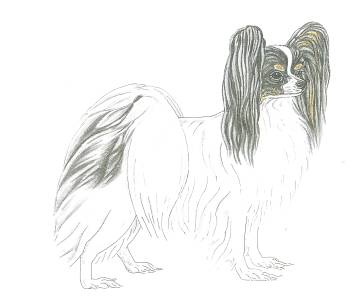 |
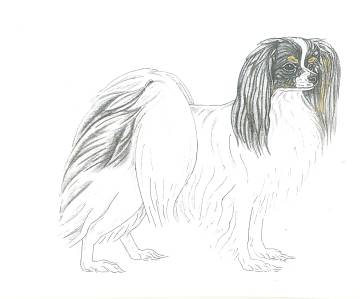 |
| A | B |
|
A and B A and B illustrate the Australian Standard, which was also the Standard used in the UK up to 1987. In this version, the ears are described as “large”. The body should have “plenty of length” which suggests that the dog should be longer, to some extent not specified, than he is high. However, later in the Standard we read that a fully-furnished dog should “appear to be slightly longer than high” (our italics). This presents an ambiguity, and is confusing. It implies that the dog should actually be square, and only look longer than its height because of his full coat. The dog shown in A and B is in fact longer in body than his height at the shoulder. However he still looks elegant, balanced and good length of leg. He is marked, according to the Standard, with tan spots above the eyes and tan on the cheeks. He is also supposed to be marked with tan under the root of the tail, only you cannot see it in this pose. He has a “white, narrow, clearly defined” blaze. The eye is required to be “of medium size, rounded and dark in colour”. This indication represents our second major confusion and point of ambiguity. “Round” is perfectly clear; “oval” and “almond” are perfectly clear – but what is meant by rounded? Particularly in conjunction with “medium size”? Should the eye be the same size as a “medium round” eye, but with slightly narrowed corners? If so the eye will then be slightly smaller than a “medium round” eye. Should it be slightly larger than a “medium round” eye, to allow for the slight narrowing? Deirdre’s drawing has taken the latter course. The muzzle should be “approximately one third the length of the head”. Our third problem! How “approximate” is the muzzle allowed to be? This dog’s muzzle is exactly one third the length of the entire head. Some might be surprised by that: we are used to looking at our dogs and making an assessment about proportion based on initial impressions – judges, especially, because they do not have any choice in the matter. This Standard does not mention chin or underjaw at all. This dog has been given a jawline of moderate strength. The Phalene is required to have ears that are “fully dropped”. No other guidance is given. No further reference is made to the requirement of an “approximately 45 degree” angle in the ear of the Papillon but it must be assumed that the ear of the Phalene must still be “set high” despite its dropped carriage. This Phalene has high set ears, but they do not reach above the line of the skull because nothing more is asked of them except they be “fully dropped”. The “approximate” angle of 45 degrees is, yet again, open to debate and interpretation. You will see, in the Illustrated Standard, sequences of drawings showing ears in the Phalene and the Papillon at angles of between 5 degrees and 90 degrees, at 5 degree intervals – decide, then, how “approximate” you think ear carriage should be in order to conform to the Standard, and how far some of the dogs in the ring today actually do conform to it! |
|
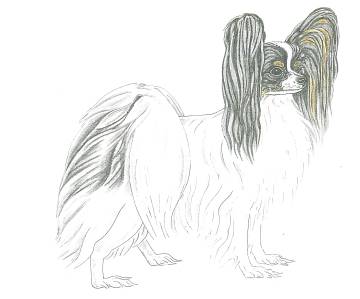 |
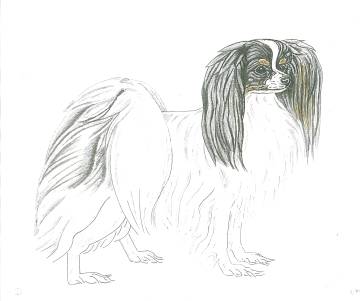 |
| C | D |
|
C and D These versions illustrate the contemporary UK Standard. The differences between it, and the old Standard still used in Australia, are few but significant. The ears are now required to be “very large”. Consequently C and D have noticeably larger ears than any other drawing in this sequence. The increased size of the Phalene (D)’s ears means that you cannot see the layback of his shoulder as well as in other versions.; The jaws are now specifically required to be “strong”, hence C and D are given a decidedly stronger jawline than the remaining 6 drawings. Despite this their heads do not look coarse or heavy. The stronger jaw does, however, give the impression of a very slightly longer muzzle – this is an illusion, the dog retains his muzzle of precisely one third the length of the head. This Standard retains the old ambiguity concerning height and length of body. In C and D, however, Deirdre has altered the body of the dog so that he is shorter than A and B, but still not square. To some eyes he will appear square. In point of fact for the dog actually to be square the body would have to be more than a centimetre shorter than in Deirdre’s drawing. If you moved the dog’s right hind leg forward by something more than the width of the pastern, then he would be square – but if you did that, you might think he was now far too tall on the leg! |
|
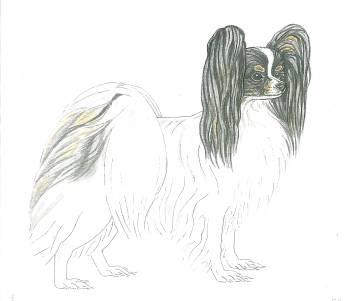 |
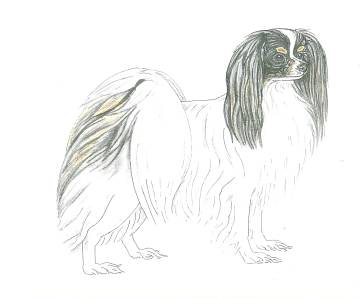 |
| E | F |
|
E and F These drawings illustrate the USA Standard. The eyes, in this Standard, are required to be “dark and round, of medium size. The head is also specifically required to be “small”. No other version of the Standard requires a small head with medium sized. round eyes. As a result, the eyes of E and F are not only round, (which makes them smaller than the “rounded” eyes asked for by two other Standards, and of course markedly different from what is asked for in the FCI Standard) they are fractionally smaller yet again by virtue of being contained in a smaller head! Therefore E and F have retained exactly the same proportions and dimensions of the other 6 drawings, but the head is a little smaller. This has the effect of making them look a little taller, and shorter. Their eyes are round but they must not be “bulging” so their roundness is not given undue prominence. The tricolour markings change in E and F because there is no mention in the USA Standard of correct or incorrect tricolour points. Thus, he has been given additional tan markings on his muzzle, on his flanks and culottes, and on the plume of his tail. This is, most people would think, very pretty. However, it would – or should – be penalised in the UK and Australia. This is food for thought; how many incorrectly marked tricolour dogs do you see in the show ring, and when do Judges ever comment on incorrect tricolour markings? As the Illustrated Standard will show, there are many Papillons with incorrect markings who are winning well even though their Standard penalises excess tan. |
|
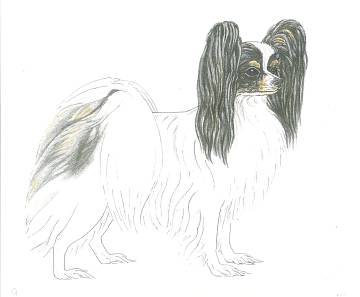 |
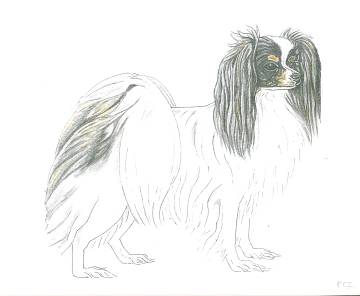 |
| G | H |
|
G and H The FCI Standard is the longest and in many respects the most detailed of the four. There are pronounced difficulties with this Standard, as well as very helpful illuminations as to breed type. Here the, eyes are required to be “rather large, well open, in the shape of a large almond, not prominent”. This is perfectly clear, apart from the fact that “large” does conflict with “rather large” to some degree. The dog in G and H has been given the requisite large, dark, almond-shaped eye which does not bulge at all and which is not so large that it threatens to dominate the skull, nor give rise to an appearance of dwarfism. In G and H the skull shows the “slight trace of medial furrow” which only the FCI Standard states is “sometimes” evident in this breed. The stop, described as “well-defined” elsewhere, is in the FCI Standard required to be “sufficiently accentuate”, thus giving rise to debate and argument about what is intended. This is partly the result of poor translation (in French, “assez accentuee” – sufficiently emphasised, or well enough emphasised) but partly the result of fundamental ambiguity. Emphasised well enough for what, or for whom? The FCI Standard goes on to make matters more complicated by stating “in the heavier dogs, this depression is less evident yet still defined: in the very small dogs it is clearly marked without ever showing sudden break”. This begs a number of questions. It is, for instance, the first and only indication that there might be two sizes of Papillon/Phalene allowed for, and two standards of appearance in this one respect. But the FCI Standard does not contain a clause concerning size – only the USA Standard does that. The requirement that the stop be emphasised but that is should be “less evident” in some dogs, and “without ever showing sudden break” in others, does suggest that the FCI Standard discourages a really well defined stop. |
|
|
This is reflected, slightly, in the heads of G and F. The point is emphasised by the next diversity from the other 3 Standards, which is that the muzzle should be “shorter than the skull” and “moderately long”. The effect of a longer muzzle, as allowed for in this Standard, will be to draw the eye away from the stop, unless the stop is very pronounced indeed Accordingly G and F not only look as though they have slightly longer muzzles, and slightly less pronounced stops, than A – D, they actually do have these features. The fact that they also have larger eyes adds to the marked differences in their heads. Deirdre has given them slightly stronger jawlines than she would have done had they had shorter muzzles, so that their heads do not appear snipey. G and F have markings identical to D and E because the FCI Standard does not specify correct or incorrect tricolour markings either. They also show a different type of blaze. Dogs A - E all have the same narrow, even, white blaze. But the FCI ~Standards says; “the white on the head extended to a more or less wide blaze”, which suggests something rather different. Hence G and F show a blaze narrowing to the stop, but broadening to a wider blaze on the skull. We hope these drawings will provide food for thought, that they will stimulate comment and debate. They are intended to illustrate the four Breed Standards as they are laid down in writing, though the illustrations may well diverge from dogs that are actually being show under those Standards. It is certain that some points – in all four Standards – are being disregarded in the interests of current fashions and fads. We actively invite comments from viewers of this Website. Deirdre probably has more experience than most of drawing Papillons and Phalenes, over many years;. nevertheless they remain artistic interpretations. Constructive criticism and comment will be very useful and helpful. These drawings can be, and will be if necessary, amended before publication. The new and complete Illustrated Standard is not just a work of art – not just a lavish and scrupulously detailed delineation of the Breed Standard - not just the product of our own experience and the experience of the many experts in the breed who are assisting us with this project– though it will be, of course, all those things. It is a document of unique importance to the breed. It is perhaps the first time,( not just for the Papillon/Phalene but for any breed,) that all the Standards in use across the world have been compared, contrasted, debated and illustrated. The number of drawings and photos will total around 800,all in full colour – we do not think anything on this scale, and in this amount of detail, has been attempted before. If it has, we certainly have not heard about it! We hope that this sequence of drawings, and others already on the Website, will help to show pictorially – better than anything we can explain in words – the depth and strength of what the Illustrated Standard aims to achieve. Please send us your comments and, if you have them, questions about the Book. |
|